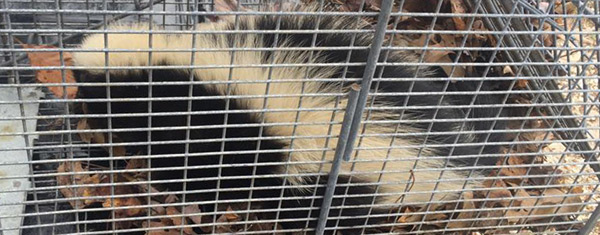- info@wildlife-removal.com
Call us for help in your town
Wildlife Removal Education
Do mothballs / ammonia repel skunks?
Need skunk removal in your hometown? We service over 500 USA locations! Click here to hire us in your town and check prices - updated for year 2020.
Most people are all for repelling skunks from their vicinity, largely because of their very undesirable attributes of being smelly and being a primary carrier of the deadly rabies virus. They also often make a mess with garbage and in yards/farms, digging cone-shaped holes as they search for grub to eat.

As a result, several kinds of formulated skunk repellants as well as DIY instructions are available in stores for interested buyers. Like most other repellents used for wildlife animals, these repellents are targeted at the skunk’s sense of smell. When effective, repellents save homeowners the cost of repairing damaged facilities and also, keeps the risk of zoonotic diseases at bay.
Of the repellent substances in circulation, the most common are mothballs and ammonia. They are believed to deter skunks because of their strong smell and stinging fumes. But how successful are these materials really, in repelling the furry mammal?
Ammonia – it is widely believed to repel most wildlife due to its pungent smell. The mode of application involves placing old rags dipped in ammonia under your deck or porch, or anywhere that skunk activity has been observed. Ammonia is particularly distressing to the eyes and nose of wildlife and has a better chance at being effective when applied in an enclosed space. It would need to be re-applied from time to time though
Mothballs – the active ingredient is a white solid substance with a strong smell called Napthalene. Most animals cannot stand the smell and would withdraw, at least for some time. The white balls are placed close to the skunk’s hideout or thrown inside its hole. Napthalene and mothballs contain an organic compound that is rather toxic for the environment and can be harmful to humans as well. Too much handling of it could predispose an individual to cancer.
In actual fact, keeping skunk away is beyond the scope and power of any repellent as the struggle for survival is real for these animals and they almost always find a way around our repellents. The most effective way to deter skunk is to remove all attractants and structurally exclude them from your premises. If you already have a skunk neighbor, humanely remove them with live traps and carry out repairs to block all entry points to your property. You may want to hire a wildlife professional to skunk-proof your house.
Go back to the Skunk Removal page.
Skunk repellent moth balls: Mothballs are the world’s cure for almost everything pest animal related. Not only will moth balls supposedly get rid of rats, they will keep out mice, drive squirrels away, stop snakes, turn around armadillos, and chase off raccoons. Now that you know everything these little, toxic balls do, you might begin to see how silly it is to think they will work all the time for everything. The only thing moth balls are good for is killing moth larvae. This is what the product was designed and approved to do. There are no other useful applications for it. It is cheap enough to try, if you’re really determined, but you need to keep in mind the little white balls are made of a known carcinogen. This means they cause cancer in lab rats and probably in people. If that doesn’t turn you away from using them, consider the fact that the toxic level of moth ball fumes for a skunk is also the toxic level for a human. The skunk won’t be able to live in the house, but neither will you. If you’re trying to use moth balls outside, don’t bother. The fumes will be lost on the winds. The outdoors is too large for mothballs to be in any way effective.


















